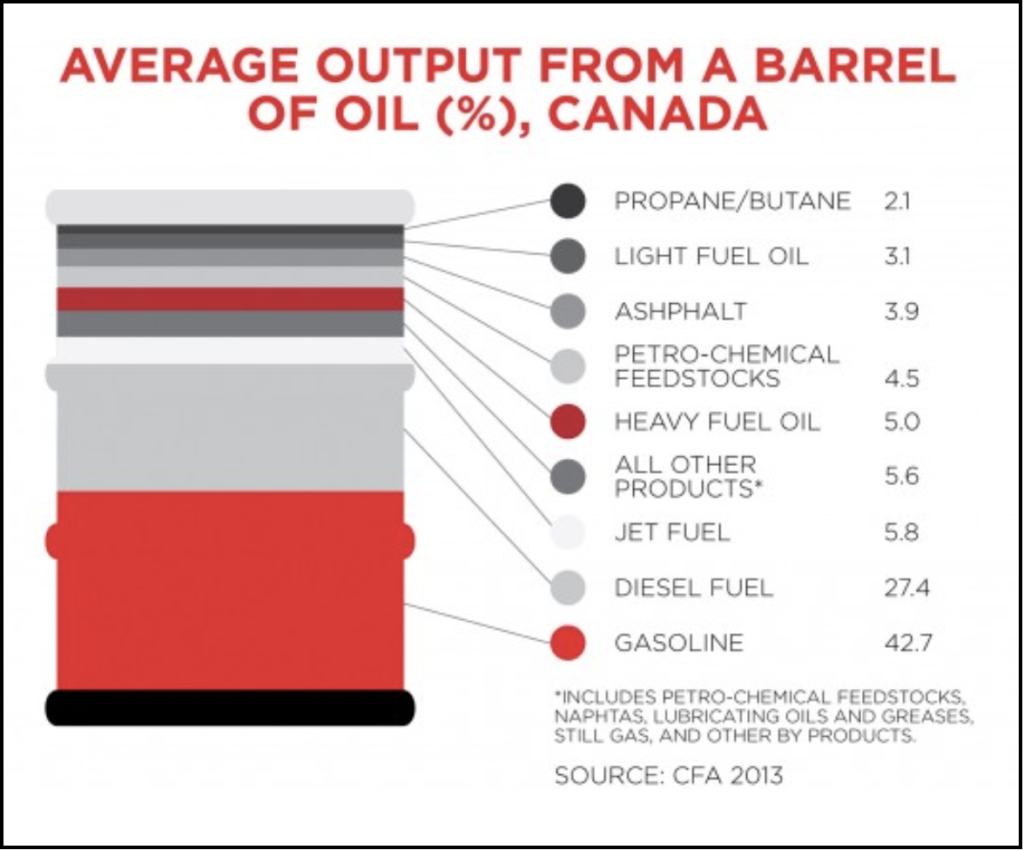Column
Keep oil in the ground?
Antil-oil activists can often be seen and heard urging governments to keep oil “in the ground.”
And that’s not just a rallying cry used by protesters here in Canada. Keep It in the Ground is, in fact, a global anti-oil movement, backed by heavily-funded organizations such as Greenpeace, the Sierra Club, Friends of Earth, and Earthjustice.
When former US president Barack Obama rejected Canada’s Keystone XL pipeline, he used similar language, arguing for a need to “keep some fossil fuels in the ground.”
Obama’s comments are a bit more measured, noting that only “some” oil will need to be kept in the ground, but either way the issue is an interesting public policy question worth examining – how would our lives be affected if governments “keep it in the ground”?
What’s a typical barrel oil used for?
When we think of oil, most of us probably imagine getting an oil change for our car or filling it up at a gas station. We might also think of jet fuel for our upcoming flight to Toronto or Jamaica.
A majority of each barrel of oil that’s refined is indeed used for transportation. However, as you can see from the Canadian Association of Petroleum Producers diagram below, there are many other uses for oil:

Approximately 4% of the typical barrel of oil that’s refined is used to make asphalt for roads, playgrounds, parking lots, shingles and other uses.
Propane takes up about 2% and petro-chemical feedstocks and “other products” take up about 10% (we’ll touch on those purposes more in a moment).
Gasoline and diesel make up the bulk of oil products, coming in at 43% and 27% respectively.
Gas vs electric cars
Some Canadians think that we’ll all soon be driving electric cars.
It’s true that electric cars have grown in popularity. With Tesla leading the way, Nissan, Chevy and many other automakers have developed electric vehicles or have committed to developing such models in the near future.
However, electric cars still only make up a tiny share of the Canadian auto market – just 3.3% of auto sales as of Q2 2019. Of the 23.1 million light vehicles registered in Canada, only around 100,000 are electric (less than 1%). It should also be noted that about two-thirds of vehicles sold in Canada today are either trucks or SUVs; categories which have virtually no electric models.
No doubt many consumers would love the low electricity bills that often come with an electric car. However, there are still many problems associated with these vehicles. A February, 2019 CBC article notes some of the drawbacks:
- Cost: Electric vehicles cost at least $15,000 more than comparable gasoline-powered models
- Range: Most models can only travel 200km or less on a single charge
- Charging stations: Drivers must plan road trips well in advance as there are far fewer charging stations than gas stations, and can be difficult to locate
- Recharge time: While it only takes a few minutes to fill up with gasoline, it can take anywhere from half an hour to 14 hours to fully charge an electric vehicle
- Climate performance: Canada’s coldest days in the winter can cause problems with electric car batteries, reducing their charge
Technology can evolve quickly, but it certainly looks as though the vast majority of Canadians won’t be driving electric cars for many years to come.
Even if we were able to purchase an electric car tomorrow, one can’t ignore the fact those vehicles are also dependent on oil. This Visual Capitalist article notes that approximately half of a typical car’s weight is due to plastics that are made from oil – click here.
Oil is also used throughout the supply chain to bring together the parts that are needed to build electric cars. Even the vehicle that delivers an electric car to your local Tesla dealership uses oil to get there.

To be clear, we’re not criticizing electric cars. But one can’t ignore the fact that if we keep oil in the ground, we simply wouldn’t have electric cars either. (If you’re interested in learning more about electric vehicles, hybrid electric and plug-in hybrid electric vehicles that are sold in Canada, we came across this CAA page with lots of good info on options for consumers– click here)
Heavy trucks and equipment
Passenger vehicles are one form of transportation that is still heavily reliant on oil, but semi-trucks and heavy equipment are even more dependent on oil.
Electric semis and other electric heavy vehicles are still in the prototype stage, with arguments over their viability still up in the air. Keeping oil in the ground would mean removing nearly half a million heavy trucks from the road in Canada, including commercial freight vehicles, Hydro trucks, fire trucks, and other vital forms of transport, industry, and emergency services.
Keeping those vehicles in park would halt the delivery of cell phones, televisions, clothes and groceries to local retail outlets. Keeping oil in the ground would also inhibit the ability of ambulances to deliver patients to hospitals, buses to drive kids to schools or fire trucks to put out the fire at the end of your street. Needless to say, there are countless other implications for society.
What about airplanes?
Looking to the skies, electric-powered airplanes don’t appear to be on the horizon in the near future. Keeping oil in the ground would mean an end to air travel – unless, of course, you took a hot air balloon or glider, but both of those vehicles would also likely use petrochemical materials (see below).
Large cargo vessels
Large transportation vessels, including container ships, are diesel-only, with no electric models in the foreseeable future.
If a product says ‘Made in China’, it was likely shipped over on one of these vessels. Fruits, vegetables and herbs also arrive via ship, including many we take for granted: bananas from South America, tomatoes from Mexico, garlic from China, etc. These imports become even more important in the fall and winter, when people still want a full range of fresh produce, but many of Canada’s farms are no longer growing it.
Electricity and heat
Oil and gas products are also used for electricity in many parts of Canada. This is especially true for many aboriginal communities that are in remote parts of the country. Citing Natural Resources Canada data, a 2019 Pembina Institute post notes that approximately 70% of large remote communities rely on diesel generators for power. According to the National Energy Board, approximately 45% of Alberta’s power comes from natural gas. (To see your province’s electricity sources – click here)
Many businesses also use natural gas for heat, to power their equipment and of course for cooking in the case of your favourite restaurant.
Daily products:
Earlier we noted that a portion of each barrel of oil is refined and used to make all kinds of products we use on a daily basis.
Ranken Energy Corporation notes there are over 6,000 products that consumers purchase that are made with oil. If you do a little digging, the results can be surprising.
Starting with your computer, cell phone or tablet – whatever you’re using to view this page – it’s safe to say it was only made possible due to petroleum products. The plastic components would have been derived from oil and of course it would have arrived in your hand thanks to diesel-powered cargo ships transporting it over from China or wherever it was made. A diesel truck would have delivered it to your local store and you may have even used a gas-powered car or diesel-powered bus to go pick it up. Even bicycles require oil for their plastic parts, grease for their gears and oil is even used to help make their tires.
The typical household offers many examples, and gives us a good idea of what would happen if we were to “keep it in the ground.” In the first place, plastics and other petrochemical materials are essential to the construction of homes themselves, being found in roofing, flooring, paint, insulation, wiring, plumbing, countertops, fixtures, panels, toilets, shower and bath stalls, appliances, and many other places, including the fasteners and sealants that hold it all together.

Once you move in, you’ll add furniture (many of which are likely upholstered with synthetic materials such as nylon), televisions, shower curtains, and blinds. Most household cleaners contain petrochemical products, and even the ones that don’t usually come in plastic bottles. Trash bags come from oil, as do recycling bins. Open the fridge or pantry, you’ll see plastic everywhere. It’s likely the same with the cupboards, especially if you have young children. As for the kids’ toys and video games? You guessed it. Plastic and more plastic.
But it’s the bathroom that likely holds the most surprises, including deodorants and antiperspirants, toothpaste, hair gel and hand lotion, soap, perfumes, lipstick, and nail polish. Spectacles and contact lenses are made from plastics, and even the mirrors might be made from acrylic or polycarbonate. And before you get dressed, check the tags on your clothes. Any synthetic fabrics, including nylon, polyester and spandex, are derived from petrochemicals. What would it be like to “keep it in the ground?” You’re better off not getting out of bed (assuming you have one, and it still has sheets).
Classrooms:
Classrooms are another place where oil plays a crucial role. Keeping in mind all the petrochemical materials that go into building a single house, you can just imagine how many it takes to build a whole school. Once things are up and running, though, you still need the pens and ink; the whiteboards and whiteboard markers; the glue, the crayons, the globes, the laminated charts, and all the binders that make learning possible. Computers, photo-copiers and printers? More plastic and more ink. Check the lockers, and most jackets, backpacks and other fashion accessories are made of synthetic fibres, not to mention the dyes that give them their bright colours.
Hospitals:
We’ve only looked in two places, and already we have a pretty good idea of what it would mean to our world to “keep it in the ground.” But of course there are all kinds of products that we don’t even think about in various industries.
For example, hospitals are highly dependent on oil. Plastics are everywhere in a hospital, from the flooring to the computers and medical equipment. Wheelchairs, syringes, latex gloves, bags for blood and IV drips: these are only the most visible examples of petrochemical products. In fact, Aspirin, antiseptics (including rubbing alcohol), bandages, antihistamines, cortisone, and many soaps include them as well. Plastic parts are essential to X-ray, MRI, ultrasound and other diagnostic imaging machines. The same is true of artificial hearts, prosthetics, dentures, and many replacement joints.
Hockey pucks, tents and chewing gum, oh my!
Petrochemical products are everywhere, and they are involved with everything we do. Even getting back to nature means bringing a tent and a sleeping bag, products which are made using nylon and other synthetic fibres. If you like sports, most equipment is plastic, including footballs, golf balls and hockey pucks. Even chewing gum needs an oil-derivative.
With all those examples in mind, is it a surprise that even anti-oil protestors can’t seem to go without oil?
Alternatives?
Make no mistake. As with individuals, some companies and other organizations are looking at alternative materials to lessen their reliance on oil. For example, the Danish toy company Lego is looking at switching to a plant-based plastic while last year, California paved its first road using recycled plastic waste.
Biodegradable, single-use water bottles and bags have also been introduced, as well as bamboo straws and reclaimed fabrics. As with electric-powered tractor-trailers, however, the viability of such projects is highly debatable, and in some cases they may do more harm than good.
Our civilization was built on invention and innovation, and there can be no question that new sources of energy are on the distant horizon. In the meantime, however, it’s important to be realistic and recognize our dependency on oil, and the miraculous technologies, breakthroughs, and ways of life its products have made possible.
Interesting links:
- Petroleum Service Company – Really good website with in-depth background info on a wide range of products: https://petroleumservicecompany.com/blog/tag/Petroleum+Product+of+the+Week
- Energy4me.org – Lots of info on the history of oil, global stats and examples of products that are made with oil: http://energy4me.org/all-about-energy/what-is-energy/energy-sources/petroleum/#15
- Ranken Energy – Listing of 144 products that are made with oil: https://www.ranken-energy.com/index.php/products-made-from-petroleum/
- Foothills Industrial Products – Lots of interesting info: https://www.foothills.ca/blog/where-would-we-be-without…petroleum-products
Research credit: Thank you to Harley Sims for help with researching this blog post and helping to put it together.



